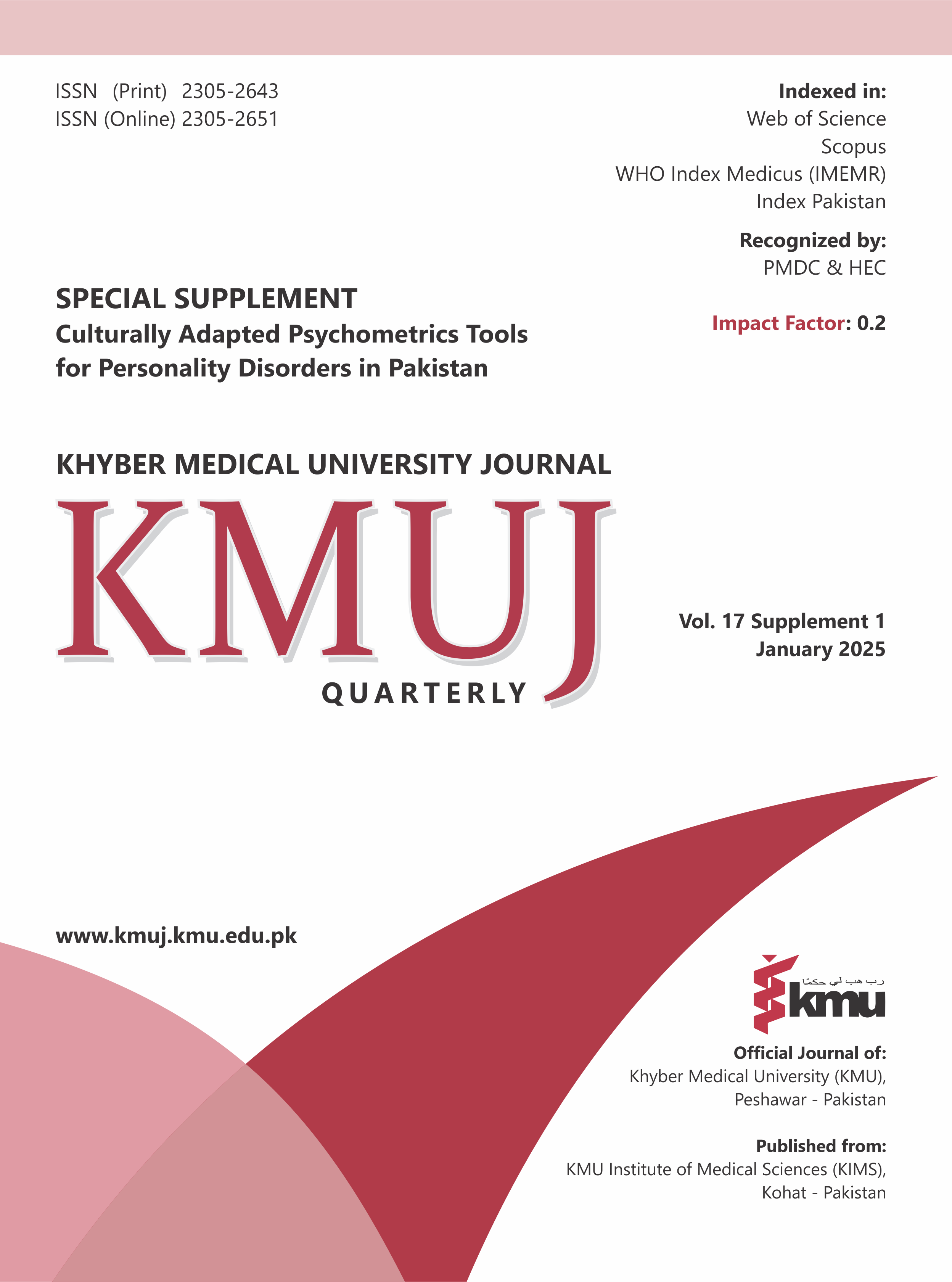Development and psychometric validation of the Urdu-language Antisocial personality disorder scale for adults
Main Article Content
Abstract
Objective: to develop an Antisocial Personality Disorder Scale (ASPDS) for adults in Urdu language and evaluate its psychometric properties.
Methods: A cross-sectional analytical study was conducted from February 15 to June 20, 2019, on 234 adults (18-60 years) from different institutions of Gujrat, Pakistan. The ASPDS was developed through diagnostic criteria, literature review, and expert validation, with an initial pool of 91 items tested on 104 adults, refined to 66 items. Exploratory Factor Analysis (EFA) identified seven factors, excluding items with factor loadings below 0.4. Confirmatory Factor Analysis (CFA) validated the seven-factor structure, resulting in a 28-item scale. Reliability was assessed using Cronbach’s alpha, and convergent validity was established by correlating ASPDS scores with the psychopathy subscale of Short Measure of Dark Triads (SD3).
Results: EFA identified seven factors explaining 62.35% of the variance, with factor loadings ranging from 0.44 to 0.73. CFA confirmed the model fit (CFI = 0.917, RMSEA = 0.063), and the final ASPDS comprised 28 items. The scale demonstrated high internal consistency, with a Cronbach’s alpha of 0.94 and subscale reliabilities ranging from 0.67 to 0.91. Convergent validity was confirmed by a significant correlation (r =0.692, p <0.01) with the SD3 psychopathy subscale. The Kaiser-Meyer-Olkin measure was 0.93, and Bartlett’s test of sphericity was significant (p <0.001). Data were analyzed using SPSS-21 and AMOS-21.
Conclusion: ASPDS is a reliable and valid tool for assessing antisocial personality disorder among adults. Its strong psychometric properties and alignment with established measures support its utility in clinical and research settings.
Article Details

This work is licensed under a Creative Commons Attribution 4.0 International License.
Work published in KMUJ is licensed under a
Creative Commons Attribution 4.0 License
Authors are permitted and encouraged to post their work online (e.g., in institutional repositories or on their website) prior to and during the submission process, as it can lead to productive exchanges, as well as earlier and greater citation of published work.
(e.g., in institutional repositories or on their website) prior to and during the submission process, as it can lead to productive exchanges, as well as earlier and greater citation of published work.
References
1. American Psychiatric Association. Diagnostic Statistical Manual for Mental Disorders. (5th ed. TR). American Psychiatric Publications; Arlington, VA, USA. 2013. ISBN: 978-0890425763. https://doi.org/10.1176/appi.books.9780890425787
2. Hashmani T, Jonason PK. Antisocial behavior. In: Shackelford TK, Weekes-Shackelford VA, (eds). Encyclopedia of evolutionary psychological science. Springer International Publishing; New York, NY, USA: 2017. pp. 1-6.
3. dos Santos W, Holanda L, Meneses G, Luengo MA, Gómez-Fraguela JA. Antisocial behaviour: a unidimensional or multidimensional construct? Avances en Psicología Latinoamericana 2019;37(1):13-27. https://doi.org/10.12804/revistas.urosario.edu.co/apl/a.5105
4. de Farias MSJA, Gomes ARF, Calheiros MB, Cavalcante HPA, Lessa MM, Neto VLM. The antisocial personality disorder and its characteristics, changes and advances: a challenge. Int J Collab Res Intern Med Public Health 2013;100(2):95-102.
5. Dean K, Korobanova D. Antisocial personality disorder managing the healthcare relationship. Med Today 2015;16(8):14-8.
6. Pemment J. Psychopathy versus sociopathy: why the distinction has become crucial. Aggress Violent Behav 2013;18(5):458-61.
7. Black DW. The natural history of antisocial personality disorder. Can J Psychiatry 2015;60(7):309-14. https://doi.org/10.1177/070674371506000703
8. Del-Ben CM. Neurobiology of personality disorder antisocial. J Clin Psychiatry 2005;32(1):27-36. https://doi.org/10.1590/S0101-60832005000100004
9. Blackburn R, Fawcett DJ. The antisocial personality questionnaire: an inventory for assessing deviant traits in offender populations. Eur J Psychol Assess 1999;15(1):14-24. https://psycnet.apa.org/doi/10.1027/1015-5759.15.1.14
10. Hare RD. A research scale for the assessment of psychopathy in criminal populations. Pers Individ Dif 1980;1(2):111-19. http://dx.doi.org/10.1016/0191-8869(80)90028-8
11. Tay L, Jebb A. Scale Development. In: Rogelberg SG (editor), The SAGE Encyclopaedia of Industrial and Organizational Psychology. 2nd ed. 2017. SAGE Publications, New Delhi, India. https://doi.org/10.4135/9781483386874
12. Jones DN, Paulhus DL. Introducing the Short Dark Triad (SD3): a brief measure of dark personality trait. Assessment 2013;21(1):28–41. https://doi.org/10.1177/1073191113514105
13. Gul-e-Sehar, Fatima I. Dark triad personality traits as predictors of bullying and victimization in adolescents. J Behav Sci 2016;26(1):51-65.
14. Mulaik SA, James LR, Van Alstine J, Bennett N, Lind S, Stilwell CD. Evaluation of goodness-of-fit indices for structural equation models. Psycholo Bull 1989;105(3):430–45. https://psycnet.apa.org/doi/10.1037/0033-2909.105.3.430
15. Hinkle DE, Wiersma W, Jurs SG. Applied Statistics for the Behavioral Sciences (5th ed). Houghton Mifflin, Boston, Mass, London, UK. 2003.
